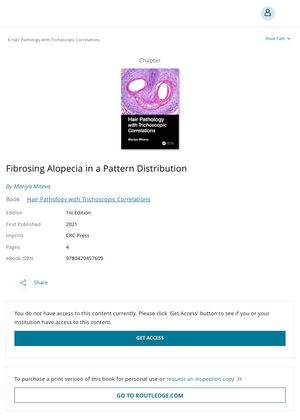Fibrosing Alopecia in a Pattern Distribution
September 2021
in “
CRC Press eBooks
”
fibrosing alopecia lichen planopilaris pattern hair loss immunologic lichenoid inflammation apoptosis-mediated process frontal fibrosing alopecia eyebrow alopecia limb alopecia facial red dots extrafacial red dots pink goose bumps atrichia trichoscopy histology peripilar casts interfollicular scale erythema pattern baldness hair thinning hair loss diagnosis

TLDR Fibrosing alopecia in a pattern distribution is a type of hair loss that may often be overlooked, especially in men.
Fibrosing alopecia in a pattern distribution (FAPD) is a diffuse form of lichen planopilaris (LPP) that affects areas of typical male or female pattern hair loss, often with some asymmetry. The cause of the immunologic lichenoid inflammation and apoptosis-mediated process in affected follicles is unclear. In a multicenter retrospective review of 26 cases, 17 men and 9 women were affected, suggesting that FAPD may be underdiagnosed in men due to less concern about common baldness. FAPD can be associated with frontal fibrosing alopecia (FFA), eyebrow alopecia, limb alopecia, and facial and extrafacial red dots. Diagnosis can be missed in a clinical exam, but "pink goose bumps" in the patterned area and dispersed ill-defined areas of atrichia may suggest FAPD. Trichoscopy and histology are crucial for diagnosis, showing peripilar casts, interfollicular scale and erythema, and single hairs or groups of hairs emerging from the same ostium in the area of thinning.





